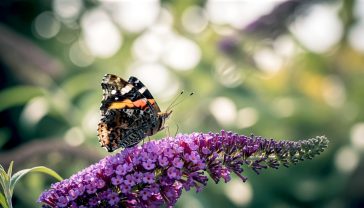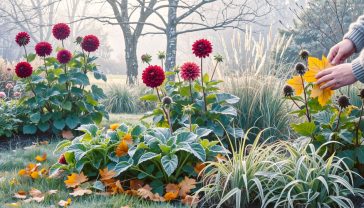A Gardener’s Alliance: Your Guide to Encouraging Beneficial Insects for Natural Pest Control
Discover how to work with nature, not against it. Our definitive guide shows you how to attract beneficial insects for natural, organic pest control in your UK garden.
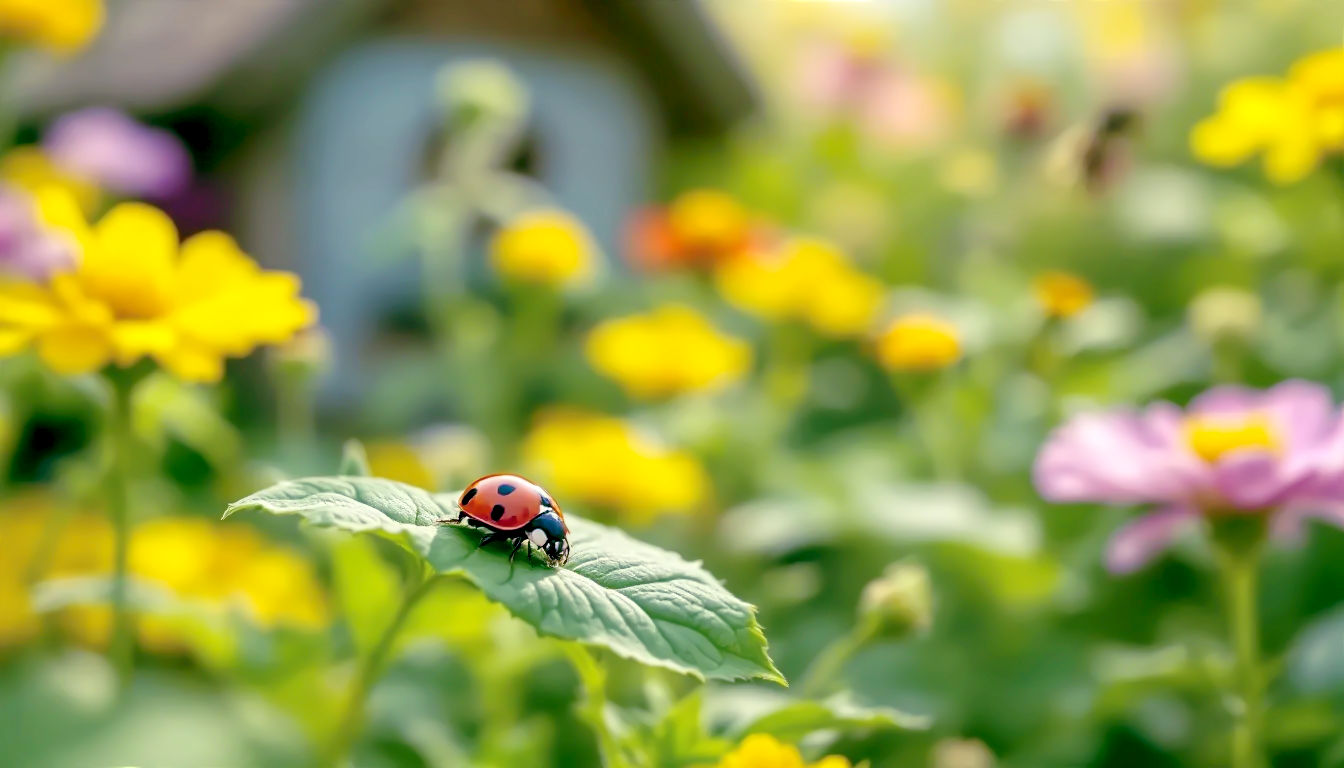
This post may contain affiliate links. If you make a purchase through these links, we may earn a commission at no additional cost to you.
Ever found yourself staring at a rose bush covered in tiny green aphids and felt a surge of despair? You’re not alone. For generations, the go-to solution was a chemical spray that promised a swift, clean kill. But as we’ve learned more about our gardens, we’ve realised that this approach is a bit like using a sledgehammer to crack a nut. It doesn’t just wipe out the pests; it harms the delicate web of life that keeps a garden thriving.
Imagine, instead, a garden humming with life. A flash of iridescent blue as a hoverfly darts between flowers. A ladybird, like a tiny jewelled beetle, munching its way through those pesky aphids. This isn’t a fantasy; it’s a living, breathing ecosystem you can create right outside your back door. It’s about working with nature, not against it. This is the heart of organic pest control—recruiting a tiny, six-legged army to do the hard work for you.
In this guide, we’ll explore how to turn your patch of Britain, whether it’s a sprawling country garden, a neat suburban lawn, or a collection of pots on a city balcony, into a sanctuary for these ‘good bugs’. We’ll delve into the fascinating world of beneficial insects, discover what makes them tick, and learn the practical, simple steps to invite them in. Forget harsh chemicals. It’s time to build a partnership with nature and let your garden find its own healthy, beautiful balance.
The Big Idea: What Are Beneficial Insects and Why Do We Need Them?
At its simplest, a ‘beneficial insect’ is any bug that helps your garden. Think of them as the good guys in a miniature wildlife drama unfolding amongst your petunias. They fall into three main groups, each with a crucial job to do.
The Predators: Nature’s Pest Control Squad
Predators are the lions and tigers of the insect world. They actively hunt down and eat garden pests. They’re your front-line defence against the critters that want to turn your prize-winning cabbages into lace.
- Ladybirds: The undisputed star of the show. Both the adult ladybirds and their rather ferocious-looking larvae are aphid-munching machines. A single ladybird can eat thousands of aphids in its lifetime. They’re the cavalry you want when greenfly descend.
- Lacewings: These delicate, green insects with lace-like wings are beautiful to look at, but their larvae are downright terrifying if you’re an aphid. Nicknamed ‘aphid lions’, these tiny predators stalk and devour soft-bodied pests with gusto.
- Ground Beetles: Often overlooked, these large, dark beetles are the night shift. They patrol the soil surface after dark, hunting for slugs, snails, and other pests that hide during the day. If you’ve got a slug problem, you want ground beetles on your side.
- Hoverflies: Often mistaken for tiny wasps, hoverflies are harmless pollinators. But their slug-like larvae have a voracious appetite for aphids, crawling through colonies and eating them one by one.
The Parasitoids: The Sci-Fi Solution
This is where things get a bit like a science-fiction film. Parasitoids don’t just eat pests; they use them as a living nursery for their young. It’s a bit gruesome, but incredibly effective.
- Parasitic Wasps: Don’t panic! These are not the big, angry wasps that ruin your picnic. Most are tiny, often no bigger than a pinhead, and you’d barely notice them. They lay their eggs inside or on top of pests like caterpillars and aphids. When the egg hatches, the wasp larva eats the pest from the inside out. One of the most common sights in a British garden is a ‘mummified’ aphid—a swollen, papery shell left behind after a parasitic wasp has done its work.
The Pollinators: The Unsung Heroes of the Harvest
While not directly involved in pest control, pollinators are absolutely vital for a healthy garden and a healthy planet. Without them, we wouldn’t have most of the fruits, vegetables, and flowers we love.
- Bees: From the familiar bumblebee to countless species of solitary bee, these are the champions of pollination. They transfer pollen between flowers, allowing them to produce seeds and fruit.
- Butterflies and Moths: As they flit from flower to flower drinking nectar, they also carry pollen with them, contributing to the garden’s reproductive cycle.
- Hoverflies (again!): Yes, they’re so useful they appear twice. As adults, they are brilliant pollinators, visiting a huge range of flowers.
By encouraging all three types, you create a balanced, self-regulating ecosystem. The pollinators ensure your plants are fruitful, while the predators and parasitoids keep pest numbers in check. It’s a win-win situation.
A Brief History of Pest Control: From Ancient Wisdom to Modern Dilemmas
For thousands of years, humans have battled pests. Early farmers and gardeners relied on observation and natural methods. They understood that a healthy, diverse environment was less prone to attack. They planted different crops together (a practice we now call companion planting) and relied on the local wildlife to lend a hand.
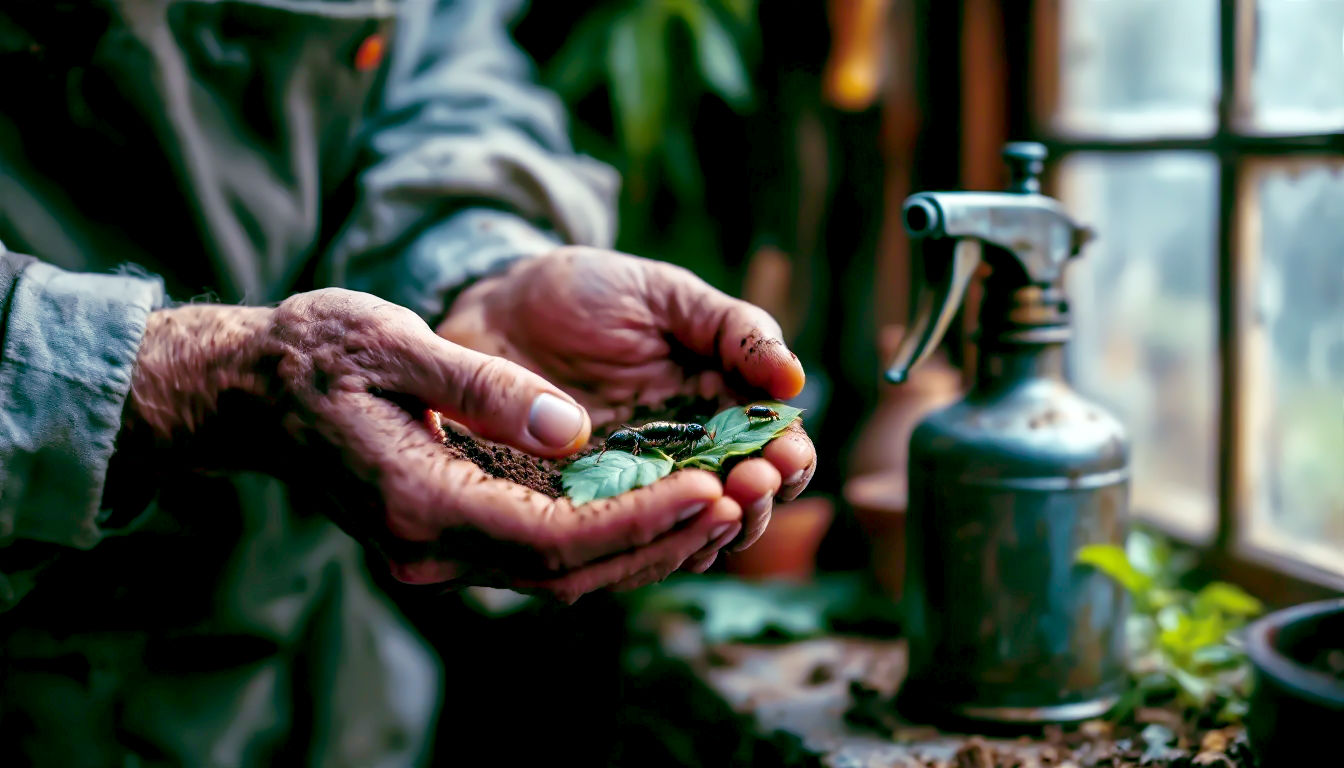
The Chemical Revolution
Everything changed in the mid-20th century. After the Second World War, new synthetic pesticides like DDT were hailed as miracle solutions. They were powerful, effective, and seemed to offer complete control. Britain, like the rest of the world, embraced this chemical revolution. Garden centres filled their shelves with sprays, dusts, and pellets for every conceivable problem.
The mantra was simple: see a bug, kill a bug. But this approach had a dark side. These chemicals were indiscriminate, killing beneficial insects just as readily as pests. They seeped into the soil and water, harming birds, fish, and other wildlife. Famously, Rachel Carson’s 1962 book, Silent Spring, sounded the alarm, revealing the devastating impact these pesticides were having on the environment. The title referred to a future where birdsong had vanished because the insects they fed on had been poisoned.
The Organic Renaissance
Carson’s book sparked a movement. Gardeners and scientists began to question the wisdom of waging chemical warfare in our back gardens. In the UK, organisations like the Soil Association and, later, Garden Organic (originally the Henry Doubleday Research Association) championed a return to more natural, sustainable methods.
They reminded us of the old wisdom: a garden isn’t a sterile laboratory; it’s a living community. The focus shifted from eradication to balance. The goal of organic gardening isn’t to eliminate every single pest, but to create a system where their populations are kept at a manageable level by their natural enemies. Today, this idea, once seen as niche, is entering the mainstream. Gardeners across Britain are realising that a healthy garden is one that’s buzzing, crawling, and fluttering with life—both good and bad.
Building Your Bug Hotel: How to Create a Five-Star Habitat
If you want beneficial insects to move in, you need to provide them with food, shelter, and water. Think of it as insect hospitality. By creating the right environment, you’ll roll out the welcome mat for your tiny allies.
Rule #1: Don’t Be Too Tidy
One of the biggest mistakes well-meaning gardeners make is being too neat. A perfectly manicured lawn, raked soil, and pruned-back-to-the-bone shrubs might look tidy to us, but to a beneficial insect, it’s a desert.
- Leave the Leaves: In autumn, resist the urge to rake up every last leaf. A layer of leaves provides the perfect winter hideout for ground beetles, centipedes, and even hibernating ladybirds. Rake them off the lawn, by all means, but pile them up under hedges or at the back of borders.
- Let a Patch Go Wild: If you have the space, leave a small corner of your garden to grow wild. A patch of long grass and native ‘weeds’ like nettles provides a vital habitat and food source for the entire lifecycle of many insects, including ladybirds and butterflies.
- Keep Dead Stems: Don’t be too quick to chop everything down in autumn. Hollow stems of plants like fennel, teasel, and sunflowers provide crucial overwintering spots for solitary bees and lacewings. Leave them standing until early spring.
Shelter: Homes for Your Garden Heroes
As well as natural mess, you can provide purpose-built homes for your insect army.
- Log Piles: A simple pile of logs or branches tucked away in a shady corner is a five-star hotel for ground beetles, centipedes, woodlice, and even slow-worms and toads (who are also excellent slug-eaters).
- Bug Hotels: These have become very popular, and for good reason. A well-made bug hotel provides a multitude of different habitats in one structure. You can buy them or easily make your own by stacking materials in a wooden frame.
- Hollow Canes and Drilled Logs: Perfect for solitary bees like red mason bees.
- Straw and Hay: Offers a dry, insulated space for lacewings to hibernate.
- Dry Leaves and Corrugated Cardboard: A favourite spot for ladybirds to shelter in winter.
- Pine Cones: The gaps provide lots of nooks and crannies for various insects.
- Top Tip: Place your bug hotel in a spot that gets some morning sun but is sheltered from wind and rain.
- Beetle Banks: This is a technique used in farming that you can adapt for your garden or allotment. It’s simply a raised mound of earth, about a foot high, planted with tussocky native grasses. This creates a warm, dry, permanent habitat for ground beetles and spiders to shelter in, right in the middle of your growing area.
Water: A Drink for the Weary
Insects need water too, especially during hot British summers. But they can easily drown in deep water.
- Shallow Dishes: A shallow saucer or birdbath filled with pebbles, marbles, or gravel provides a safe place for insects to land and drink. The pebbles give them a platform to stand on so they don’t fall in.
- Ponds: A garden pond, even a tiny one made from an old sink or barrel, is the single best thing you can do for wildlife. It will attract dragonflies and damselflies, whose larvae eat mosquito larvae. It also provides a water source for all your garden visitors, from bees to birds and hedgehogs.
The Gardener’s Buffet: Planting for Beneficial Insects
The single most important food source you can provide is flowers. Many beneficial insects have a two-part lifecycle. The larvae might be voracious predators, but the adults often feed on nectar and pollen. If you don’t provide food for the adults, they won’t stick around to lay their eggs.
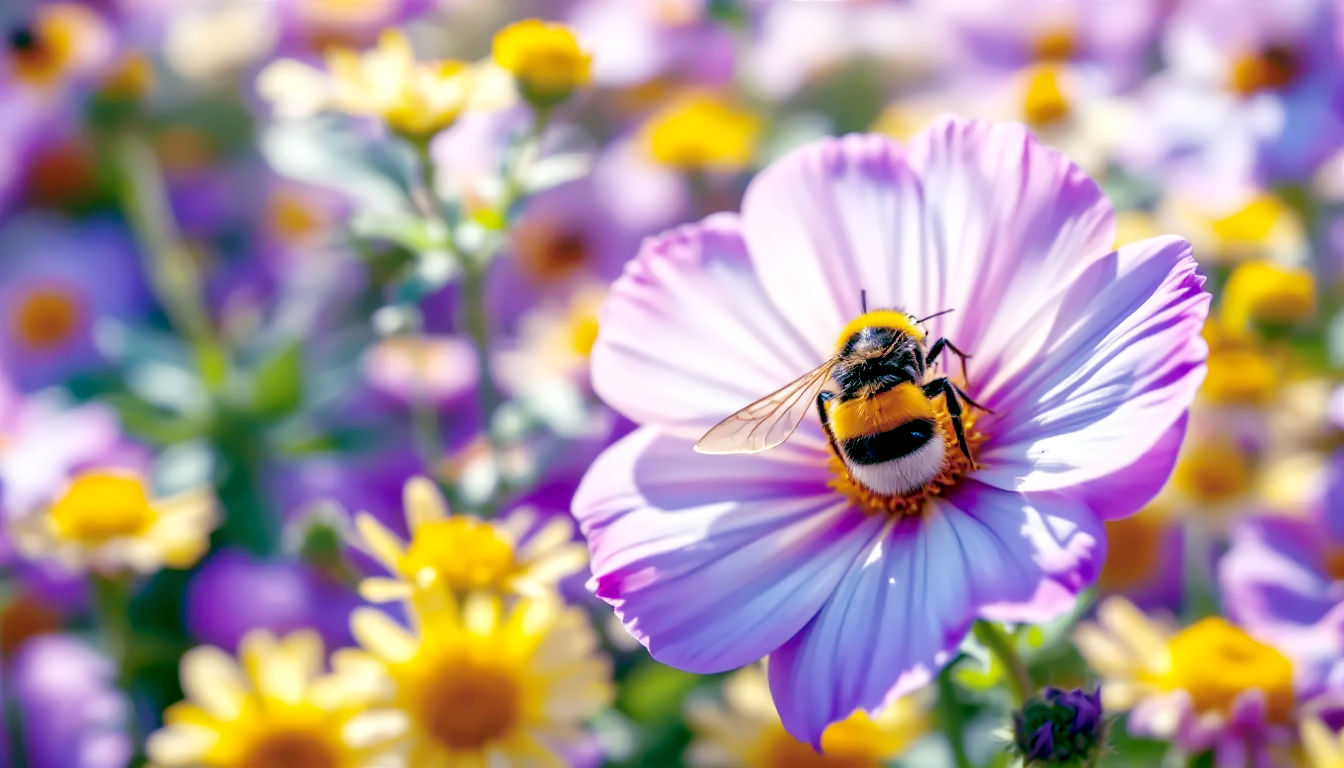
The key is variety. You want a garden that has something in flower for as long as possible, from the first crocuses of late winter to the last asters of autumn.
What Makes a Flower Insect-Friendly?
Not all flowers are created equal in the eyes of an insect. Many modern, highly-bred flowers, like big fluffy roses or double begonias, have so many petals that insects can’t actually get to the nectar and pollen inside.
The best choices are simple, single flowers where the central parts are easy to access. Think of old-fashioned cottage garden plants. Native wildflowers are also fantastic.
A Plant Menu for Your Insect Allies
Aim for a mix of shapes, sizes, and colours to attract the widest range of insects.
The Umbellifers: Landing Pads for Tiny Flyers
These plants have flat-topped flower heads made up of lots of tiny individual flowers. They are irresistible to hoverflies, lacewings, and tiny parasitic wasps, who have short mouthparts and need easily accessible nectar.
- Cow Parsley (Anthriscus sylvestris): The classic British hedgerow plant.
- Fennel (Foeniculum vulgare): A beautiful, feathery herb with yellow flowers.
- Angelica (Angelica archangelica): A tall, dramatic architectural plant.
- Carrot and Parsnip Flowers: If you grow your own veg, let a few plants ‘go to seed’ (flower) at the end of the season. The insects will thank you for it.
- Coriander and Dill: These herbs also produce the same type of flower.
The Daisies: A Pollen-Rich Feast
Plants in the daisy family (Asteraceae) are like a giant buffet table. The central disc is actually made up of hundreds of tiny individual flowers, packed with pollen and nectar.
- Cosmos: Easy to grow from seed, they flower for months on end.
- Marigolds (Calendula): Not to be confused with French Marigolds (Tagetes). The simple, single-flowered pot marigold is a magnet for hoverflies. It’s also said to deter some soil pests.
- Michaelmas Daisies (Asters): Provide a vital late-season food source when little else is flowering.
- Yarrow (Achillea): A hardy perennial with flat flower heads in a range of colours.
- Cornflowers (Centaurea cyanus): A beautiful blue cottage garden favourite, loved by bees and hoverflies.
Herbs and Scented Plants
Many culinary herbs are fantastic for beneficial insects. Let them flower and you’ll be rewarded with a buzz of activity.
- Lavender: Adored by bees of all kinds.
- Rosemary and Thyme: Provide an early source of nectar.
- Borage: A brilliant plant for bees. Its flowers replenish their nectar very quickly, so bees can visit them again and again. The leaves are also edible (they taste a bit like cucumber).
- Mint: If you can keep it contained, its flowers are hugely popular with pollinators.
Planting for Pests (Yes, Really!)
This might sound counter-intuitive, but sometimes you need to provide a food source for the pests themselves. This is known as a ‘sacrificial crop’ or ‘trap crop’. The idea is to lure pests to a plant you don’t care about, which concentrates them in one place. This makes them an easy target for predators and parasitoids, helping to build up their populations early in the season.
- Nettles: A small, managed patch of nettles is an essential nursery for the caterpillars of beautiful butterflies like the Peacock and Red Admiral. It’s also where ladybirds often go to lay their eggs, as nettles are frequently home to early-season aphids.
- Nasturtiums: Cabbage white butterflies often prefer to lay their eggs on nasturtiums rather than your prized cabbages. They also attract aphids, which in turn will attract ladybirds.
Putting It All Together: A Year in an Organic Garden
Building a balanced ecosystem takes time. It won’t happen overnight. But by making small, consistent changes, you can gradually shift the balance in favour of the good guys.
Spring
- Don’t Dig Too Much: Avoid digging over your soil unless you have to. Digging can damage the soil structure and harm overwintering ground beetles and other soil dwellers. Apply a layer of compost or mulch to the surface instead.
- Wait to Weed: Let early-flowering ‘weeds’ like dandelions and dead-nettles bloom. They provide a critical first meal for bees and hoverflies emerging from hibernation.
- Hold Off on the Tidy-Up: Wait for a few warm days before cutting back old, dead stems. This gives overwintering insects a chance to wake up and emerge safely.
- Plant Early Flowers: Ensure you have plants like crocuses, lungwort (Pulmonaria), and primroses to get the season started.
Summer
- Provide Water: Keep your insect water dishes topped up, especially during dry spells.
- Let Herbs Flower: Don’t be too zealous about harvesting your herbs. Let some of them flower to feed your allies.
- Monitor Pest Levels: Keep an eye out for pests. But don’t reach for a spray at the first sight of an aphid. Look closely. Can you see any ladybird larvae or hoverfly larvae among them? Give the predators a chance to do their job. If numbers get out of control, a simple jet of water from a hose or a wipe with a cloth is often enough to knock them back.
- Deadhead Flowers: Regularly deadhead plants like cosmos and calendula to encourage them to produce more flowers, extending the feeding season for your insects.
Autumn
- Plant for Late Nectar: Plant late-flowering species like asters, sedums, and ivy to provide food for insects preparing for winter. Ivy is particularly important as a late source of nectar for bees and hoverflies.
- Create Your Winter Shelters: Build your log piles and beetle banks. Leave seed heads on plants like teasel and rudbeckia for birds and insects.
- Leave the Leaves: Rake leaves into piles under hedges or create a leaf mould bin.
Winter
- Plan Ahead: Winter is the perfect time to plan your garden for the year ahead. Look through seed catalogues and choose single, open-flowered varieties. Plan where you can incorporate more insect-friendly plants.
- Build a Bug Hotel: A great winter project for a cold day is to build or repair your bug hotel, ready for its new residents in the spring.
- Disturb as Little as Possible: The garden may look dormant, but it’s full of sleeping life. Avoid tidying up too much and let your beneficial insects rest undisturbed.
The Future is Biological: Working with Nature on a Grander Scale
The principles we’ve discussed for our back gardens are now being used on a massive scale in commercial horticulture and agriculture. Farmers and growers are releasing millions of beneficial insects into their fields and greenhouses to control pests, reducing their reliance on chemical sprays. This is known as biological control.
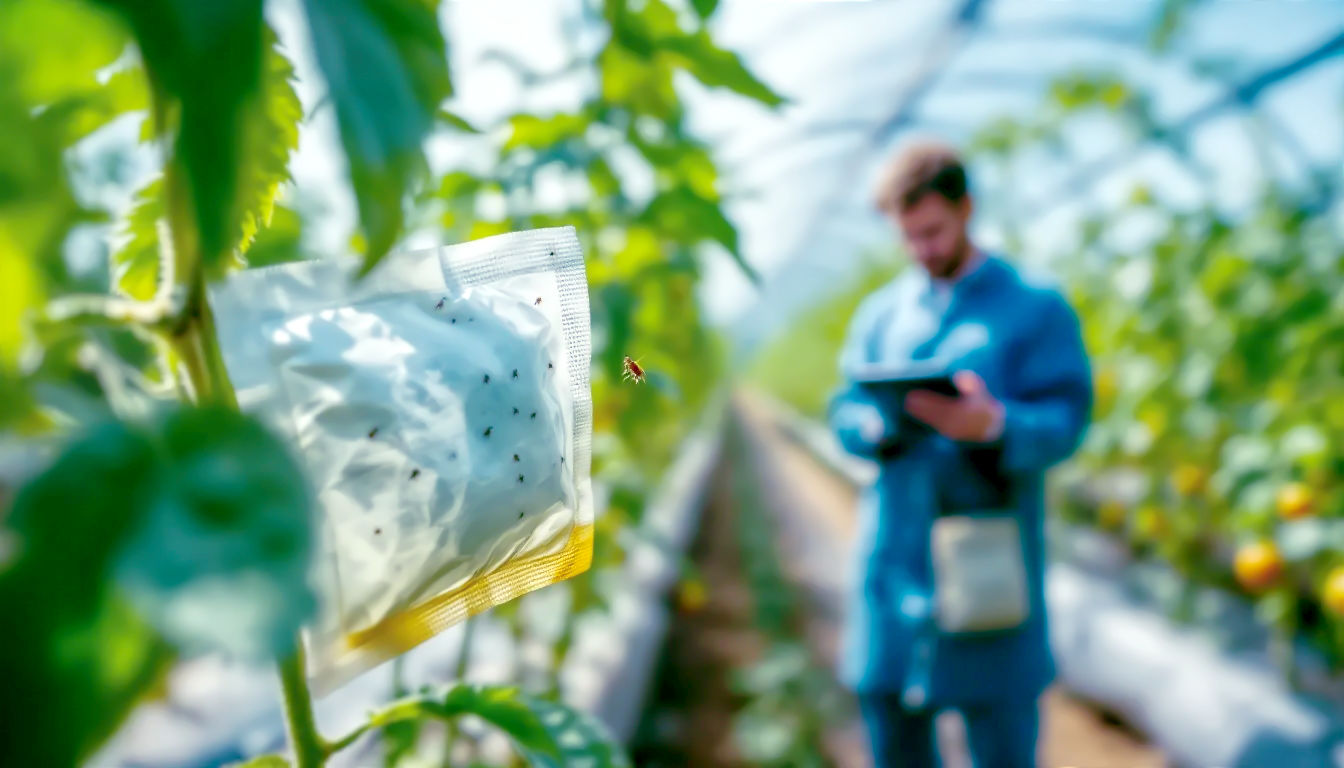
In the UK, companies breed specific predators and parasitoids to tackle specific pests. For example, growers of tomatoes in giant greenhouses will release parasitic wasps to control whitefly, and predatory mites to control spider mites. This isn’t just better for the environment; it often works better than chemicals, as pests can’t develop resistance to being eaten.
This shift shows that encouraging beneficial insects isn’t just a quaint hobby for gardeners; it’s a robust, scientific, and sustainable approach to food production. By adopting these methods in our own gardens, we are part of a bigger movement towards a healthier, more balanced relationship with the natural world.
Your garden is more than just a collection of plants. It’s a complex, fascinating, and dynamic ecosystem. By learning to see it this way—by providing food, water, and shelter for the smallest of creatures—you can transform it into a resilient, self-regulating, and beautiful space. You won’t just be growing flowers or vegetables; you’ll be cultivating life itself. And in return, that life will help your garden to flourish.
Further Reading
For those keen to delve deeper, these highly respected British organisations offer a wealth of information:
- The Royal Horticultural Society (RHS): A leading source of gardening advice, with extensive resources on encouraging wildlife and managing pests organically. https://www.rhs.org.uk/
- Garden Organic: The UK’s national charity for organic growing, offering practical advice, courses, and research on sustainable gardening. https://www.gardenorganic.org.uk/
- The Wildlife Trusts: A nationwide network of trusts dedicated to conserving the UK’s wildlife and wild spaces, with fantastic advice on making your garden wildlife-friendly. https://www.wildlifetrusts.org/
- Buglife: The only organisation in Europe devoted to the conservation of all invertebrates. Their website is a treasure trove of information about insects and how to help them. https://www.buglife.org.uk/


